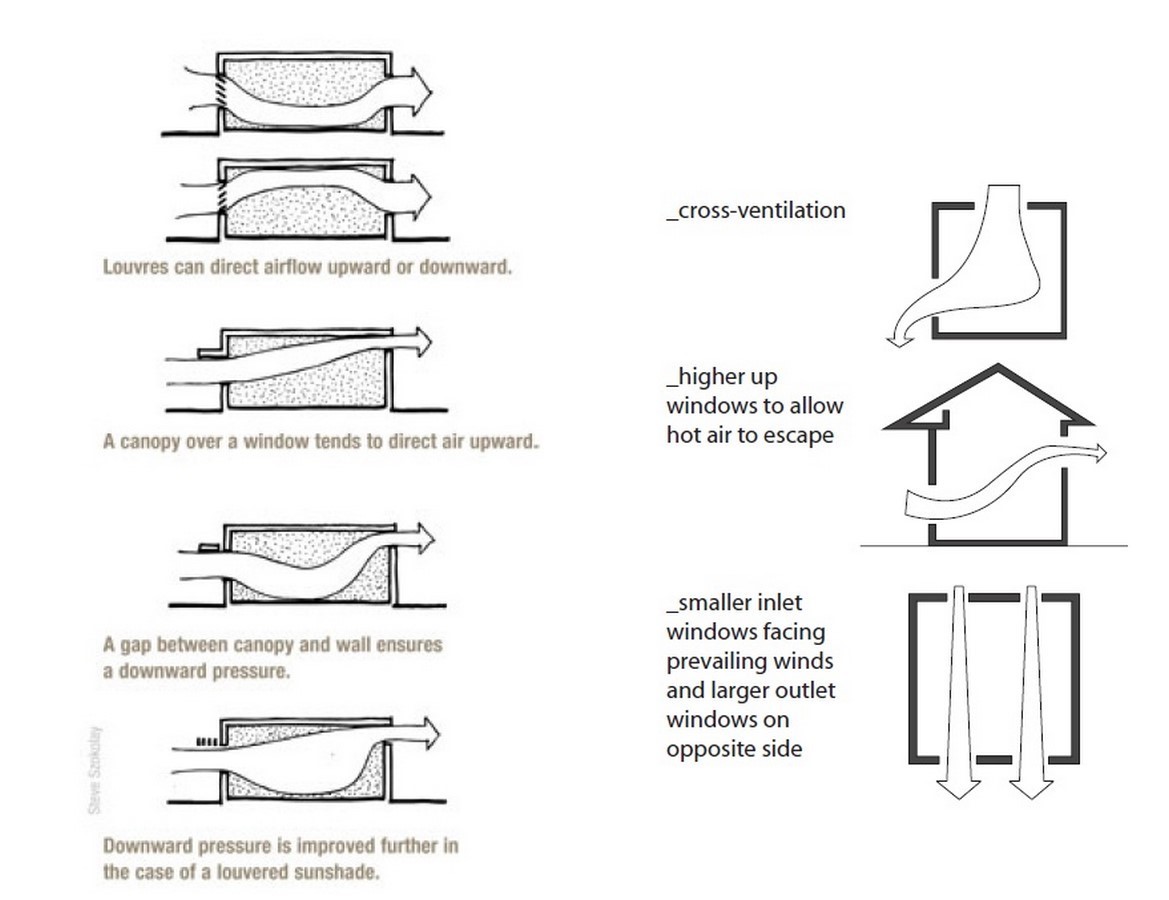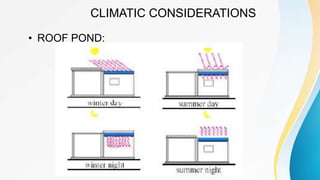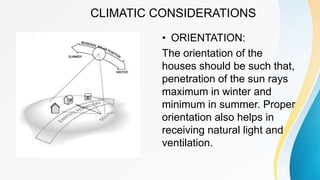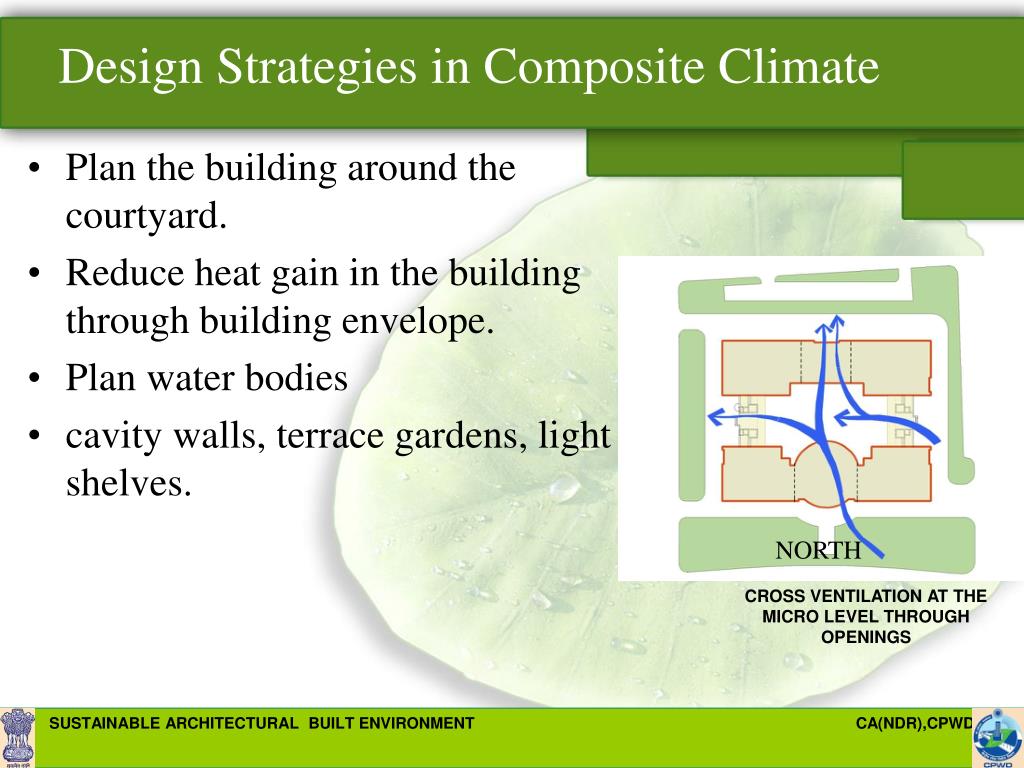The passive design strategies for composite climate and also presents the various methods of passive cooling techniques. This communication presents design considerations and thermal performance of a hostel building using passive techniques for a composite climatic con.

Design Of A Sustainable Residence In Composite Climate Of India
For a half year it could display the following weather conditions.

. The composite climate zone covers the central part of india. Pavement Design Considerations. A CASE STUDY OF HOT DRY AND WARM HUMID CLIMATES IN NIGERIA.
The buildings south face should receive sunlight between the hours of 900 AM. The scope of work for projects may include a copy of the completed RRVA for reference or the Design Consultant may request a copy. Often referred to as climatology it is to study the various climate-based influencing factors on our living conditions particularly under the heads of seasonality sunlight rain wind and humidity of the target construction site for maximal dialogue between the structure and its surroundings in particular the climate.
Incorporation of solar passive techniques in a building design helps to minimize load on conventional systems such as heating cooling ventilation light. Moreover there currently exists a lack of in-depth research on the influence of design strategies on the energy consumption of high-rise buildings in tropical climate Raji et al 2016. The Composite Climate was chosen to study due to its annual.
Passive solar systems basic rules-1. Warm and humid 3. Composite pavement designs Rehabilitation and overlays Evaluates effects of specification changes MEPDG.
With reference to the same the prompted design considerations vary. Composite region Characteristics of the composite region are very hot and dry summer followed by a humid season with monsoon rains. Considerations for buildings to become comfortable include realisation of an open barrier between the indoor and outdoor climate make use of solar and natural ventilation strategies and allowance for human intervention in climate control to satisfy subjective needs Fountain et al 1996.
Double walls with insulation in between are a suitable solution. The actual comfort conditions achieved will be contextual and depend on the building topology and building design specifications. Recommendation for composite climate eg.
The place experiences three definite seasons. The key of design take an advantage of local climate microclimate for human comfort. Solar radiation outside air wet surfaces vegetation etc means in composite climate.
There are certain design considerations for composite region buildings which should resist heat gain in summer and resist heat loss in winter. And the sky conditions are againvariable which because it experiences all the 3 seasons. This communication presents design considerations and thermal performance of a hostel building using passive techniques for a composite climatic condition of Delhi India.
An architects aim would be to. It is becoming evident that strategies to reduce energy consumption in buildings have a direct impact on the performance of the exterior building skin. So composite climate receives3 distinct seasons summers monsoons and winters and the conditions vary in each ofthese seasons which is what the problematic causes.
Hot and dry 2. This helps in receiving less radiations which results in lesser heat gain reduces the overall air conditioning requirement thus saves energy Proper orientation also helps in receiving natural light ventilation. Now the physiological objectivefor composite climate becomes very difficult.
A square plan with a courtyard would be very effective. Cold Climate HVAC by A. Design the devices to perform more than one function.
The design process uses these zones as a basis for the pre-liminary design of the composite part. The climate resilience design considerations for each of those linked sections as well as additional climate resilience resources by section are included in this document for easy reference. CLIMATIC CONSIDERATIONS PROJECTIONS.
Use north-facing high thermal mass living areas with passive solar. CLIMATIC CONSIDERATIONS IN ARCHITECTURAL DESIGN OF BUILDINGS IN TROPICS. Hot-dry early summer warm-humid late summer monsoon period and cold-dry period in winter.
Similarly the ice and snow assessment can contribute to the decision process regarding envelope design. Mahdavi and Kumar 1996. Envelope Design Considerations.
ORIENTATION OF BUILDING In composite climate the orientation of the buildings is preferable in North-East South-West Directions. The flat roof is a good reflector and re-radiates heat efficiently especially if it consists of a solid white painted material. Use minimal heating or cooling.
Architectural considerations for composite climate introduction. 42 M-E Pavement Design Process Climate Structure Response Materials Distress Damage Time Accumulation Traffic Iterations. This climatic zone is not normal as seen in hot and dry or any other climatic zones.
Design for climate means that a home is designed or modified to. Climate responsive architecture takes into consideration seasonality the direction of the sun sun path and solar position natural shade provided by the surrounding topography environmental factors such as wind rainfall humidity and climate data temperature historical weather patterns etc to design comfortable and energy-efficient. Delhi and Gurgaon.
The size of the windows on the east and west sides should be minimized in order to reduce heat gain. Large projecting eaves and wide verandahs are needed in composite climate as out-door living areas to reduce sky glare keep out the rain and provide shades. Orient the buildings with longer axes in the east-west direction.
CLIMATIC CONSIDERATIONS JALIS. 0 45 90 and 45 in each zone. This paper focuses on various bioclimatic design strategies Orientation of building plays a vital role in achieving energy for building design in a composite climate like Delhi.
And 300 PM during the. The air-conditioning and lighting consumption can be reduced by in- corporating climate-responsive features in the design. Jalis on the outer facade of the building helps in cooling shading and ventialtion.
Compact form with low SV ratio is recommended. CLIMATE RESPONSIVE DESIGN STRATEGIES IN COMPOSITE CLIMATE In passive solar energy mechanical means are not employed to utilize solar energy. East and west orientation should be protected by buffer spaces shaded walls etc.
A rectangular form with a longer axis along the north-south is the preferred orientation. The building should be elongated on an east-west axis. Design considerations Choose a site exposed to cooling breezes and design to exclude adverse winds while allowing for cross-ventilation and night purging.
This is a zone-based design in which the CAD software assigns a given num-ber of laminates simply defined by the total number of plies and their orientations usually conventional angles. Passive strategies provide thermal and visual comfort by using natural energy sources sinks.

Architectural Features Of Composite Climate In India

Architectural Features Of Composite Climate In India

Architectural Features Of Composite Climate In India

Ppt Sustainable Architectural Built Environment Powerpoint Presentation Id 3564604

10 Things To Remember When Designing In Tropical Climate Rtf Rethinking The Future


0 comments
Post a Comment